After Losing His Wife to Suicide, A Skier Finds Respite in the Mountains
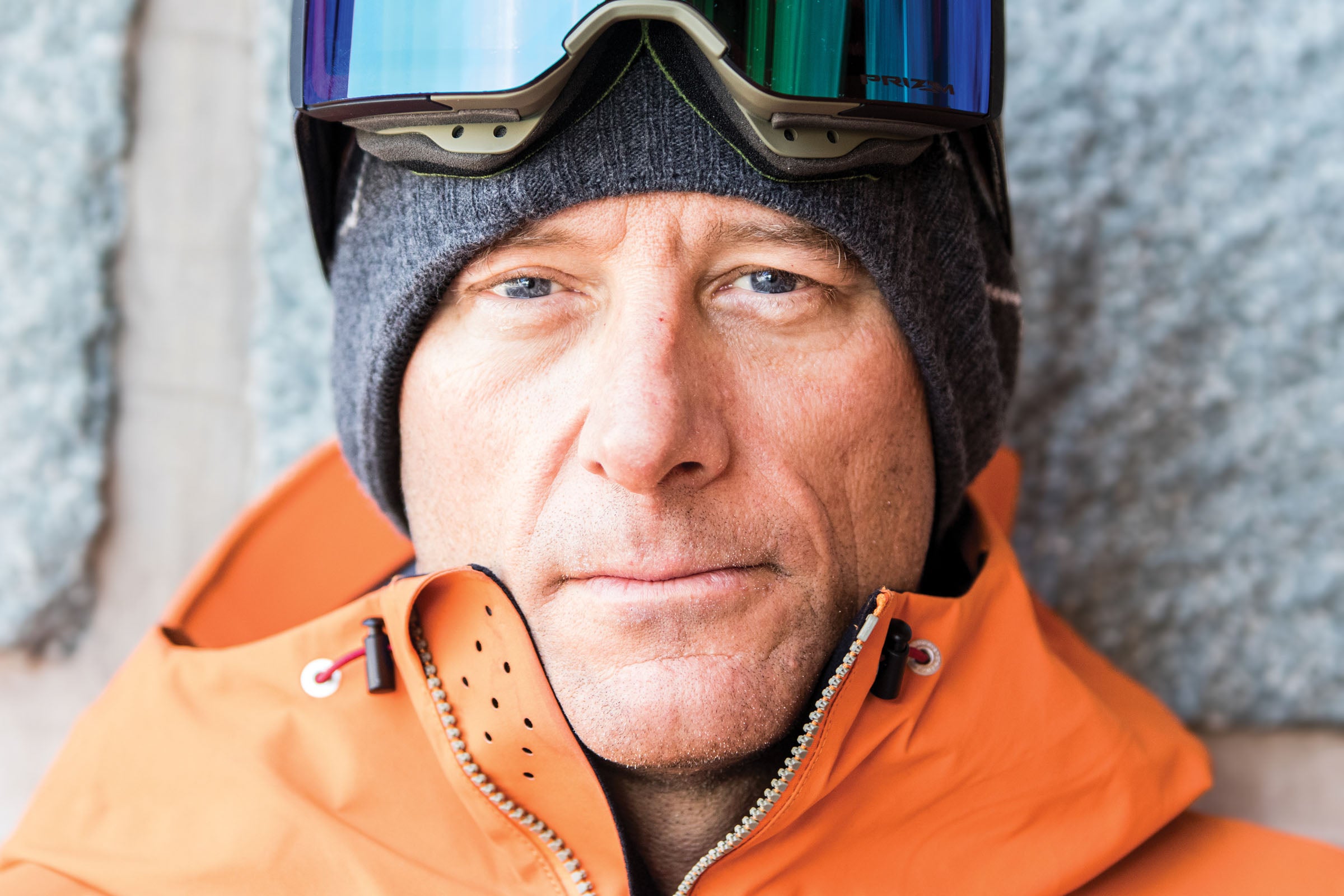
Photo credit: Liam Doran
Sven Brunso built a life in front of the camera, arcing powder turns on breathtaking terrain around the globe. It was a coveted life, which he shared with his beloved wife, Beth, and their two children, in the spectacular Colorado mountain town of Durango. But on Christmas Day 2016, his life would be forever altered by a suicide that stunned the whole community.
Sven Brunso emerges from the dark, chilly shade just as Storm Peak’s north face comes into view. It looks like a monster: 3,400 vertical feet of steep rock and snow at the head of Velocity Basin in Silverton, Colo. The 13,487-foot peak’s aptly named Gnar Couloir, our objective for the day, plunges off the summit ridge like a mine shaft, ending in a cliff. A series of small, point release avalanches have damaged the snow in the couloir, but Brunso remains optimistic.
It is early May in Brunso’s beloved home range, the mighty San Juans. For a man who has made a career out of skiing bottomless powder around the world, the sight of a runneled, manky line in his backyard is hardly ideal. But as he knows better than most, such is life sometimes. We strap our skis to our packs and begin punching steps up the face.
Two hours later we reach the top. We can hear the Durango & Silverton Narrow Gauge Railroad train chugging into town a few miles south. Brunso looks at his watch: 11:35 a.m. “Right on time.” Then he drops into the abyss. We make carefully executed jump turns down to where the couloir closes out, then exit onto the shoulder and exhale. “Sometimes there’s good skiing, and sometimes there’s novelty,” Brunso says. “That was the latter.”
The fact that he is still grinning despite the survival turns surprises me. But knowing the grief he has overcome in the past two years makes it easier to understand why skiing—even in brutal conditions—is so precious. And so vital.
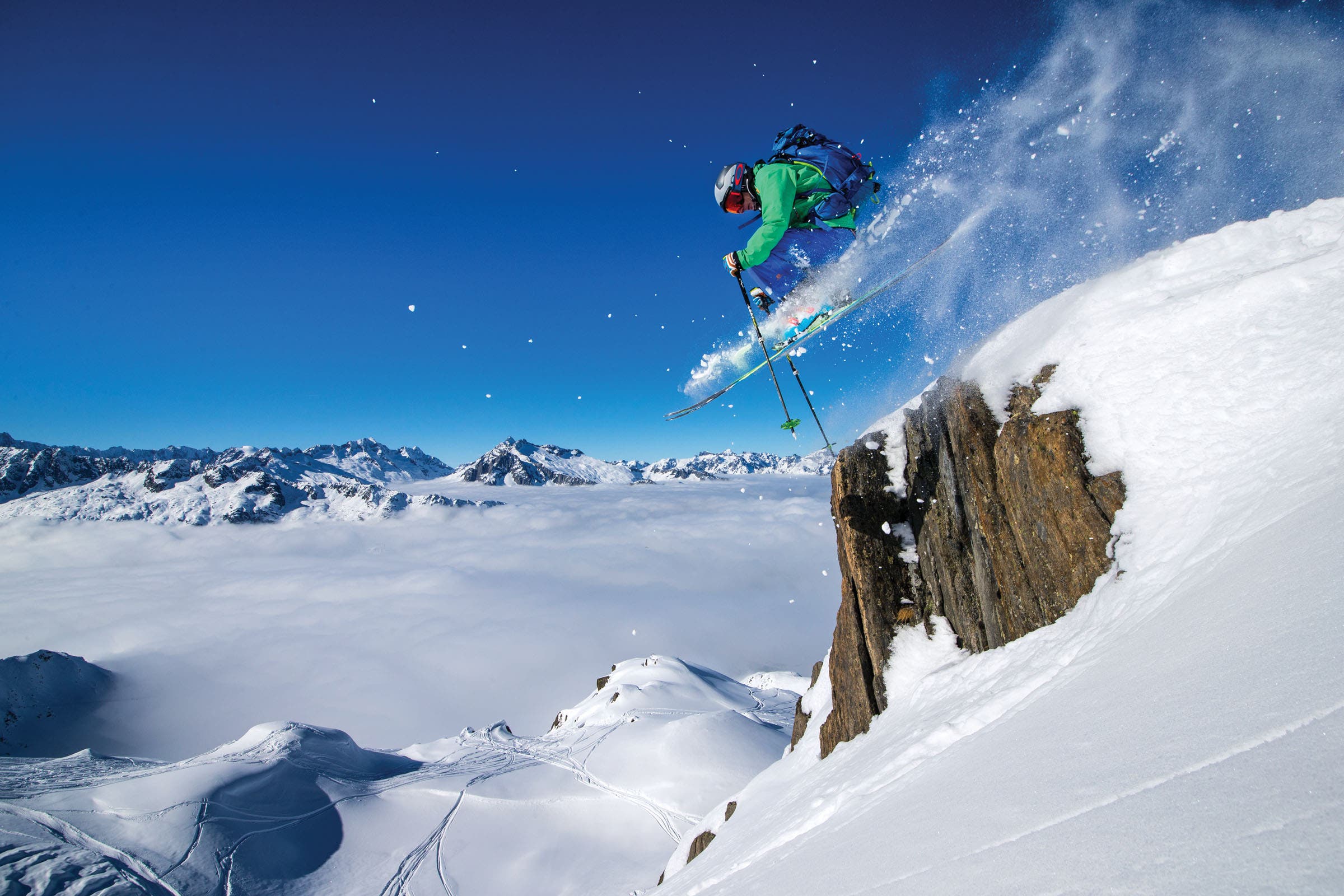
Ever since they had children, Sven and Beth Brunso did the same thing on Christmas Day: Wake up at their home in Durango, open presents, eat breakfast, hang out as a family, then go their own ways for a couple of hours before reconvening for dinner and a movie. Sven usually spent his afternoon skiing, while Beth went for a run.
The 2016 holiday started like every other, then they prepared to part ways. “Aspen wants to go over to a friend’s house and watch a movie, are you OK with that?” Beth asked Sven, referring to their then-16-year-old daughter. “And if you want to go to Hesperus and take a few runs, we’ll get back together for the movie at 5.”
It was a welcome reprieve for Sven after a chaotic Christmas Eve and delicate morning. The night before, Beth and Aspen, who were more like best friends, got into a vicious argument in which hasty things were said and both left fuming. Beth stormed out their front door into a winter storm, wearing only a light jacket. Sven spent three hours driving around town, searching for his wife. When he finally found her, Beth told him: “I’ve lost faith. I just get sad sometimes because I feel like I’m not contributing enough to the family. You’re working so hard, working all these jobs, it feels like you never stop, and sometimes I feel like I’m a burden, like I’m taking more out of the family than I’m giving. You and Aspen and Stowe would be fine if I wasn’t here.”
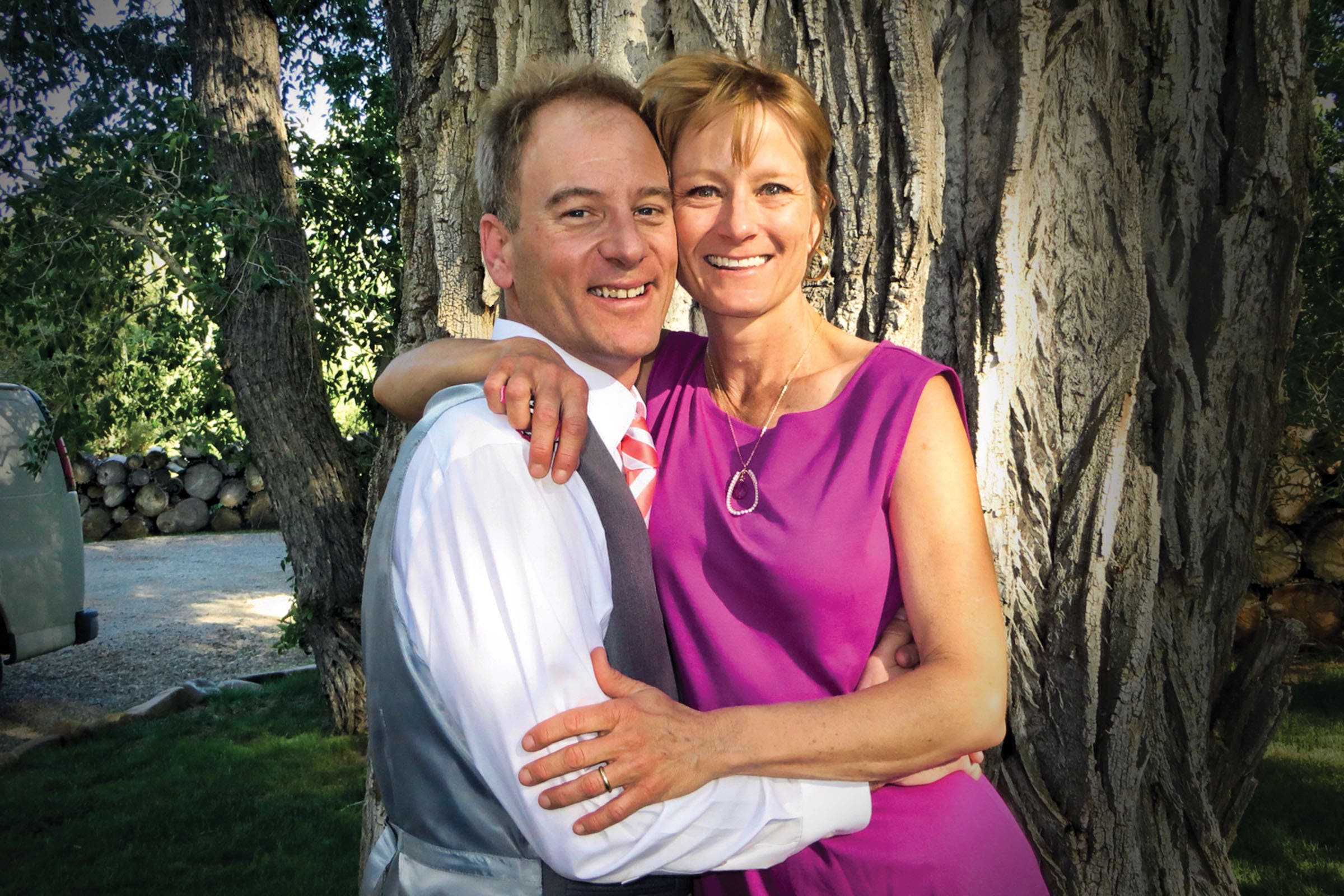
On Christmas morning, the mood seemed to brighten. Despite the absence of their son Stowe, who was 18 and living in Grand Junction, Sven, Beth, and Aspen had a long talk in which mother and daughter apologized. Beth recanted what she’d said to Sven. “I was just being negative,” she said. It seemed like there was closure.
When Sven got home from skiing at 4 p.m., he found Beth asleep in their guest room, a half-finished beer bottle in her hand. He placed it on a ledge, then took their dog for a walk. At 5 o’clock he tried to wake up Beth. But he couldn’t. Soon he would learn the crushing truth: that his wife of 21 years, a bubbly, doting, beloved fourth-grade teacher, had killed herself.
Sven spent much of his professional life producing the perfect image. As the most photographed skier in history, he’s appeared in more than 2,500 print images and on 120 magazine and newspaper covers. Everything looked so exceptional on the snowy surface. He was paid to make it so. His personal life appeared just as idyllic. He and Beth met in the summer of 1989 after both transferred to the University of Arizona. He held the door for her, a pretty blonde track star from Northern Arizona, and they ate lunch together in the cafeteria. “I walked back downstairs, got in the car with my dad, and said, ‘I just met the woman I’m going to marry,’” Sven recalls. “And he kind of reached over and patted me on the leg. ‘Easy now. There are 20,000 girls at this school. I wouldn’t be so sure so fast.’”
They had been dating for three weeks when, on their way to a movie in Tucson, Beth told Sven something she’d never said out loud before.
“I don’t think I’m going to live very long.”
“What?” Sven said. “Pull over.” Beth stopped the car. “Is there something I need to know? Do you have a terminal illness?”
“No, I don’t even know why I’m telling you this,” Beth replied. “I’ve just never thought I was going to live very long, but I want to make the most out of the years I have.”
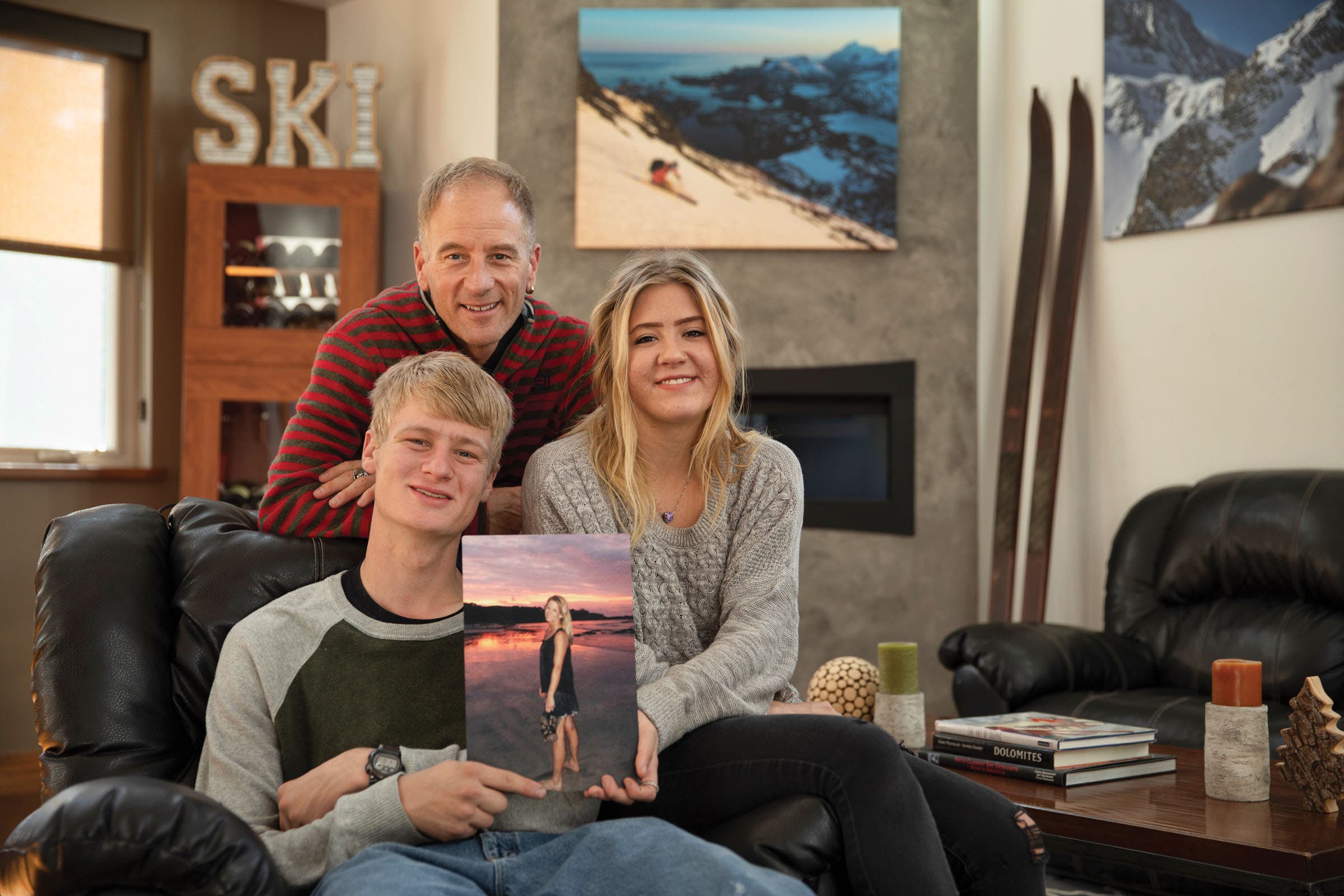
Sven and Beth moved to Durango after college. In 1994, he proposed halfway up 14,012-foot North Maroon Peak in Aspen. Beth always encouraged him to chase his dream of becoming a pro skier—just as his dad had done while Sven was growing up. From the morning he left home at age 18 to attend Fort Lewis College in Durango, Sven and his dad, Jim, a middle-school counselor, talked on the phone every day, even when it cost $4 a minute.
In June 1995, a few months before Sven and Beth were to be married, he and his dad visited a ghost town called Animas Forks outside Silverton. They were driving home when Jim said: “You know what? If I were to die tomorrow, I’m the happiest guy in the world. I’ve had an amazing marriage, I’m so proud of you, and you’re marrying the girl that you love.” Then he told Sven where the paperwork was for his house and life insurance. “Mom will be taken care of,” he said.
Sven was perplexed. “You’ve never talked like this before,” he said to his dad.
Less than 24 hours later, Sven’s parents were involved in a head-on collision near Tuba City, Arizona. Jim died instantly. He was 56. Sven’s mother, Sandy, who was driving, broke 28 bones and was given last rites. She spent two months in intensive care. When she got out, Sven told her what Jim had said, only to learn she’d had a similar experience. Two weeks before they left for Colorado, she came downstairs to find Jim holding his head in his hands with tears in his eyes. “What’s the matter?” she said.
“I just don’t think I’m going to be here very long,” he replied. “Why do you feel that way?”
“I don’t know, it’s just a premonition.”
Four days after Jim’s death, Sven delivered his father’s eulogy on what would’ve been his parents’ 35th wedding anniversary. He made a list of things that Jim had taught him and handed it out at the service. Among them: Always root for the underdog, always consider the other person’s feelings, never put yourself above anyone else.
“Losing my dad was a huge deal for me, because we were best friends,” Sven says, tears welling in his eyes 24 years later. “But Beth totally stepped in and assumed that role.”
Beth was like an angel, not just to Sven but to hundreds of kids and needy people in Durango. When they decided to have children, she told Sven to keep shooting and traveling, even though it brought meager compensation. Stowe and Aspen lit up their days. “All she ever wanted was to be a good mother,” Sven says. “That was her driving force in life.”
Sven traveled often, which wore on him. As much as he loved skiing powder around the world, he wanted to be home with Beth and the kids. She wrangled Stowe and Aspen to the soup kitchen down the street and fed homeless people every Wednesday night—the same ones who yelled at them for being “rich” because they lived in a house on a quiet street near the Animas River. (Says Sven: “I work four jobs to live here.”) On Thanksgiving, Beth cooked for anyone who didn’t have somewhere to go, up to 30 people some years. “In every relationship she had, she was always the giver and the fixer, making everything all right,” Sven says. “When I talked to her friends after she died, they were all like, ‘She never once asked for anything.’”
People would see Sven and Beth together and think they were the happiest marriage in town. But she struggled with self-doubt. She tried anti-depressants but said the euphoria felt artificial. Stowe has high-functioning autism and was forced to live in a residential treatment facility growing up. Beth hated that. In November 2015, a little more than a year before her death, while Aspen was at home and Sven was out of town for a sponsor obligation, Beth mixed a few sleeping pills with a beer and wrote a suicide note. Aspen found out and made her throw up. Afterward, Aspen told Beth what an important part of her life she was and how much she needed her. Beth started crying. “The biggest thing was it broke my heart because I was downstairs,” says Aspen, now 19, who’s had two friends attempt suicide. “I told her, ‘I wish you would’ve come and talked to me.’”
Beth started seeing a therapist once a week. Sven accompanied her for a visit after a few months, to check in. “The therapist said, ‘Beth doesn’t need me anymore,’” Sven recalls. “‘She knows when she’s getting into that negative space, and she has the tools to fix it. There’s nothing I can add at this point. She’s stable.’”
Two months after her suicide attempt, Beth’s longtime friend and former owner of the Red Snapper restaurant, where Sven worked as general manager, killed herself. Her name was Karen Langhart. Before she did it, she mailed Sven and Beth a package via Priority Mail. It contained a letter in which she told them how much she loved them. It also included photos she’d taken of their family and life lessons to impart to Stowe and Aspen. Beth called Sven to tell him Karen had killed herself. “I don’t care how heavy things are in your life,” Beth said. “How could you leave your husband and son behind? I just don’t understand it. There’s never going to be another day when they’re not going to think about this.” The episode made her realize how misguided her own attempt had been, she told Sven.
It would be hard to find a bigger underdog on skis than Sven. The only child of non-skiing parents, he grew up skateboarding with Steve Caballero and Stacy Peralta in Huntington Beach, Calif., before moving to Prescott, Ariz., in the fourth grade. To pay for gear and Poma rides, he mowed lawns and bagged groceries. His local resort had 37 skiable acres.
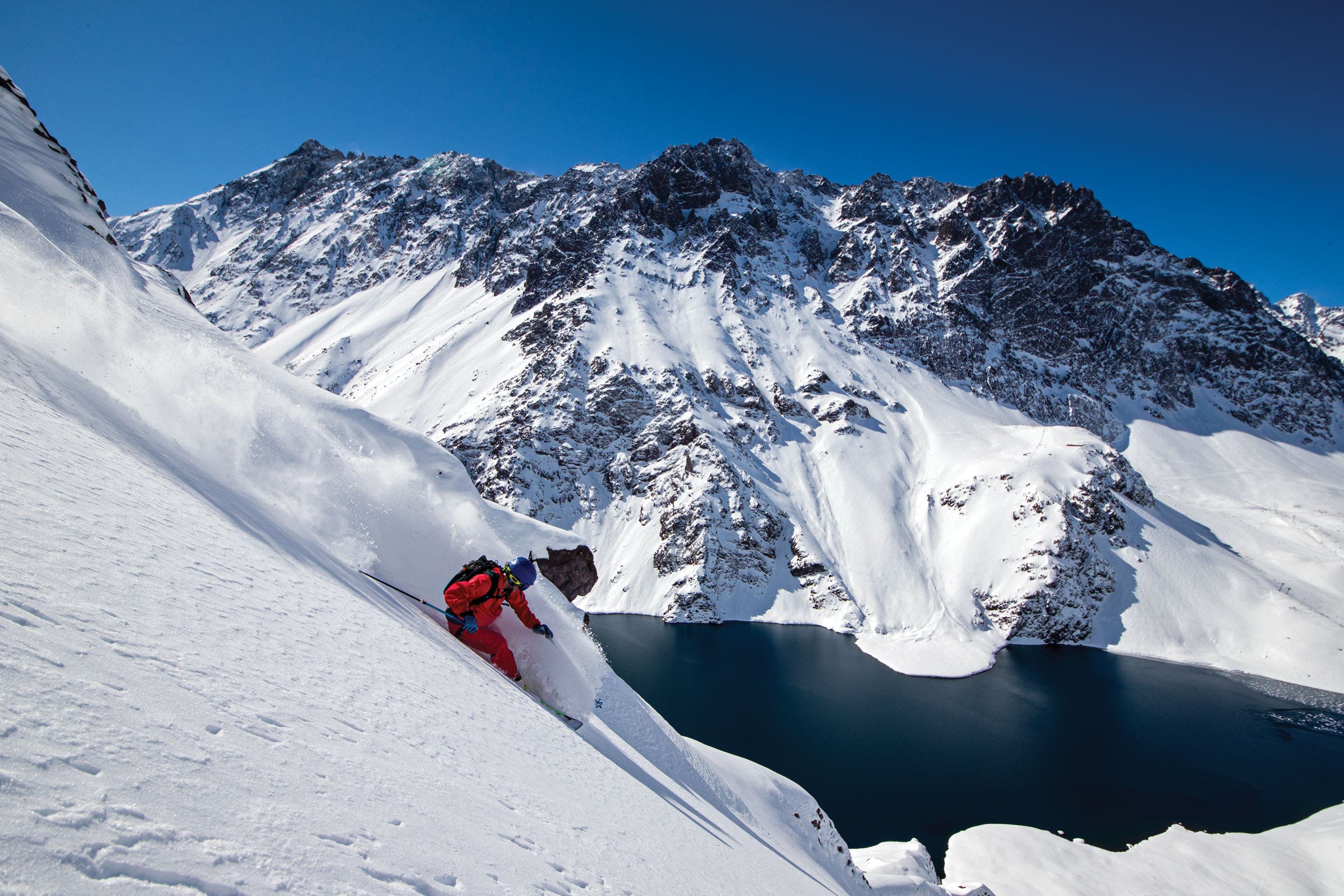
By the time he landed in Durango in 1992, Sven had never taken a lesson or raced, but his technique was solid. He pledged to himself that no one would ever outwork him. He got up early to scout light and locations days in advance, and earned the nickname Svenergizer for his willingness to hike from sunrise to sunset. After skiing 277 days in the 1997-’98 winter, he got his break in the fall of ’99, landing on the cover of Men’s Journal and the Powder Buyer’s Guide. He’s also been on the cover of U.S. News and World Report, almost every ski magazine worldwide, and the Daily Mail. If you have a spare half-hour, he will gladly break down the art of a perfect powder turn from one nanosecond to the next, taking into account snow density, speed, photo composition, the position of your leading hand, the position of your trailing hand, and why it’s important to not look like a unicorn with your pole. “Before social media existed, my goal was to get about 50 photos a year to show up in the endemic ski publications,” Sven says. “One for every day I shot.”
Professional skiing never made him much money—enough for a mortgage payment sometimes, or to chip away at Aspen and Stowe’s college education. This wore on him. In 2001, he decided he was going to quit. He said it again in ’06, as well as ’09. When he finally did quit, in 2012, Beth could tell he wished he hadn’t. “Why are you not doing this?” she said one night at dinner. “If it’s something you truly don’t want to do anymore, that’s OK. But if you don’t want to do it because you think the kids and I need you to be here, we’d rather have you be gone a month or two each winter and be totally present when you’re here. How many skiers are getting calls from people who want to take them around the world?”
Beth died of a lethal dose of alcohol and prescription drugs. “It was shocking,” recalls Beth’s longtime friend Christina Rinderle, Durango’s mayor at the time. “When Sven told us that she died, I immediately thought, was it a car accident? I never would’ve thought in a million years that she would’ve been a suicide.”
Beth was one of 16 suicides in 2016 in La Plata County, where Durango is the county seat and the suicide rate is more than twice the national average. Colorado has the ninth-highest suicide rate of the 50 states. Montana has the highest, and nine of the top 10 rates are in the Mountain West. One prominent Colorado doctor calls this the “paradise paradox.” Mental health professionals have conjured many theories as to why people are more likely to kill themselves in the Rocky Mountains, from the rise of social media to the lack of oxygen. Durango psychologist Doug Miller has a different take.
Miller, who’s been practicing in town for 17 years and worked out at the same gym as the Brunsos, calls Durango’s suicide problem “a crisis in our community.” But it’s not a mental health problem, he argues. It’s a public health problem. He is trained in acceptance and commitment therapy, or ACT, which is based on the theory that “no thought, no feeling, has ever killed anybody. But our attempts to avoid thoughts and feelings that we don’t like contributes to more suffering,” Miller says. “Some of us turn to drugs and alcohol, others turn to outdoor activities. But those thoughts and feelings still show up. And the ultimate form of avoidance is suicide. ACT tries to teach people that a life fully lived comes with hurtful thoughts and feelings, and we don’t have to try so hard to avoid them. We have to learn to live with them.”
Miller believes it’s easier to isolate oneself in a town like Durango, where locals commonly do things outside alone. “People are less likely to kill themselves if they have a greater sense of connection with people in their community,” he says. “In our mountain towns, we have a greater sense of disconnection. And there’s a lot of opportunity to get out and play in the mountains. Does that contribute to less time connecting with others? Maybe.”
Beth had plenty of connections in Durango, but as Sven would find out later, she’d been holding in a brutal trauma for 30 years. “I thought I knew everything about my wife; I didn’t think we had any secrets,” he told me. “But after she died, one of her really good friends told me that she had been raped in high school.” Beth confided in someone she trusted about the assault, her friend told Sven, but that person didn’t support her. Soon it happened again.
Beth’s father had been diagnosed with dementia shortly before her death. She didn’t know if she wanted to keep teaching. Her hamstring was failing. “Two dozen things that if any one of them was taken out of the mix, maybe this doesn’t happen,” Sven says. She didn’t leave a note, which makes him think she made her decision impulsively.
After her death, the Brunso refrigerator filled up with casseroles for a week. Then they stopped. No one knew how to react to a seemingly healthy person killing herself in such a happy place. “That was one of the most shocking things about all of this,” Sven says. “How much support there was for the first 10 days, then, with the exception of a few people, it was just kind of gone.”
For three weeks after Beth’s death, Sven didn’t ski. “I felt this panic of ‘I can’t be away from the kids, I have to be here more.’ The easiest thing to do was just step away from skiing altogether.” Aspen talked her dad out of it. “Don’t do that, because that’s not what Mom would want,” she said. “It might be what you think is right, but it’s not what you need. Stowe and I are good, we’ll take care of each other.”
”When a local photographer proposed a sunset shoot at Purgatory, where Sven spent 12 years as Vice President of Sales and Marketing, he acquiesced. He hiked the same jump 15 times until the shot was perfect. For the first time since Beth’s death, his mind had been freed. “I realized that was my therapy,” he says. “I didn’t need to be in a 12-by-12 office talking to somebody who hadn’t been through what I had. I needed to go out and remember what I loved. And I noticed that when I came back and had to deal with all the paperwork, I was able to focus on it because I had been able to step away.”
”Among those whose counsel he sought, his mother—a widow for two decades by then—told him to expect “extremely difficult” anniversaries and holidays. “It does get better,” she reassured him. “Your memories will be more about the good stuff and the lessons learned and things that were left behind, instead of this emptiness. The void gets filled.”
Sven also reached out to Matthias “Super Frenchie” Giraud, a pro skier and BASE jumper whom he mentored in the early 2000s. Frenchie was one of the only people Sven knew who’d dealt with the suicide of a family member: He was 18 when his older sister Bibi—who spoke five languages and had two graduate degrees—committed suicide. Frenchie identified her body. He spent time angry. “Eventually, later on, as weird as it sounds, I learned to respect her actions,” Frenchie says. “We keep hearing that we’re in charge of our own existence, which also means we’re in charge of our own death. Sometimes it has to be on your own terms.”
Frenchie’s insight resonated. Sven still gets angry sometimes, not at Beth but the situation he and his kids are in. He questions what he could have done differently and rues the years they should’ve had together. More than anything, he misses his soulmate. In 25 years, they had fewer than five arguments, and all were trivial. Still, he couldn’t relate to Beth’s sorrow. “I love life. No matter how bad my days are, I find beauty in the simplest things,” Sven says. “I don’t want to say that I’m detached from what happened, but I’m not going to let it be an albatross. I respect that it was her life, and whether she chose to live it or end it, that was her decision.”
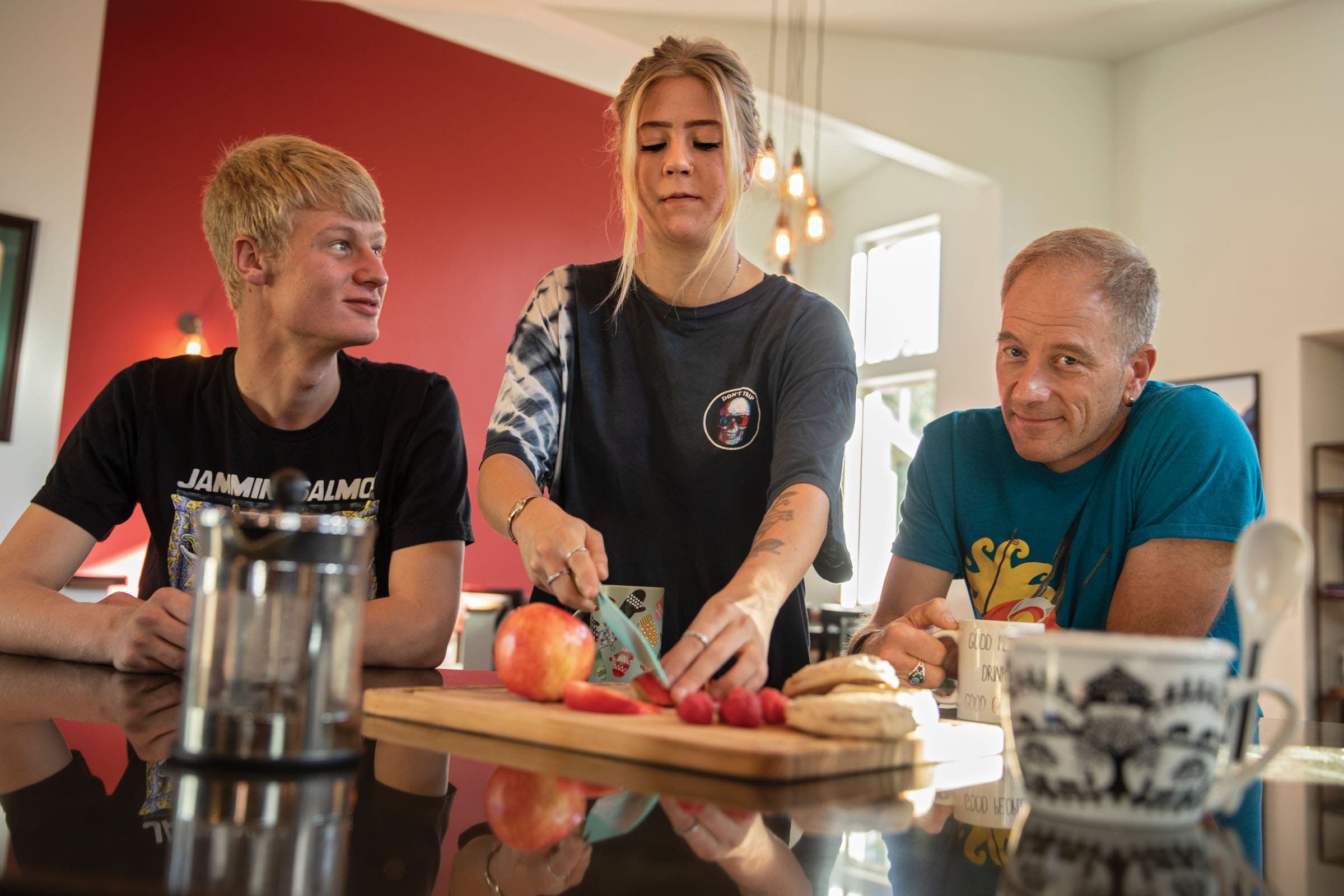
Beth’s organs were donated to eight people. A newborn got two of her heart valves. Others received her corneas and her kidney. A 30-year-old woman who hadn’t been able to take a deep breath for years got her lungs—and promptly turned into an athlete.
During my three-day trip to ski with Sven last May, perhaps the most surprising revelation he makes is that he is finally ending his professional ski career. This, despite the fact that he made more money from skiing last winter, two years shy of 50, than he ever has. His sponsors say they’re going to keep sending him gear, and photographers will probably keep calling. But he says he’s serious this time.
“He’s like the boy who cried wolf,” chuckles Aspen. “I’ll believe it when I see it.”
But lost among all the trips to Japan and Norway and Portillo were the ones he turned down with cousins and friends. “I haven’t gone on just a fun, personal ski trip since the early ’90s,” he says.
The next morning, we get up early and drive to Silverton to ski the Gnar. At 49, Sven is superfit and still carries some of his ’90s flair, with a hoop earring and bright Oakley shades. He comes across serious: doesn’t laugh often, and talks about heavy subjects with a tone of acceptance and little emotion. We hike up Yankee Boy Basin the following day, then soak in the Ouray hot springs. On our last morning we climb and ski perfect corn from the Red Mountain Alpine Lodge, one of a handful of destinations Sven has helped market behind the scenes (he also helped lay out Silverton Mountain before it opened). It will be one of his final professional shoots. Lest anyone get the wrong idea, he still loves skiing and will likely still notch 160 days a year. But he has enough life experience to know what makes him content, and it’s at home.
One day last January, Sven was about to leave town for a while. Aspen, who was living five blocks away and working at Purgatory, wanted to see him before he left, so she came over at 7 a.m. to eat breakfast with him and Stowe. Sven cooked his kids pancakes and eggs. All three of them sat together sipping coffee and talking. “For most people,” Sven told me later that day, “this is probably a normal thing: having breakfast with your kids. But it made me so content to think, you know, everything in life is not perfect. But right now, I am as happy as I could be.”
“Winter’s Last Light” originally appeared in the December 2019 print edition of SKI Magazine. For more SKI delivered directly to your mailbox, SUBSCRIBE NOW.